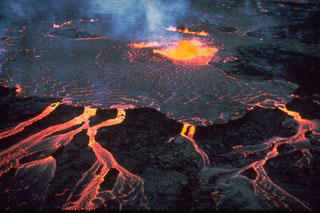Report on Kilauea (United States) — 30 November-6 December 2016
Smithsonian Institution / US Geological Survey
Weekly Volcanic Activity Report, 30 November-6 December 2016
Managing Editor: Sally Sennert.
Please cite this report as:
Global Volcanism Program, 2016. Report on Kilauea (United States) (Sennert, S, ed.). Weekly Volcanic Activity Report, 30 November-6 December 2016. Smithsonian Institution and US Geological Survey.
Kilauea
United States
19.421°N, 155.287°W; summit elev. 1222 m
All times are local (unless otherwise noted)
During 30 November-6 December HVO reported that the lava lake continued to rise and fall, circulate, and spatter in Kilauea’s Overlook vent; the lake level rose as high as 7.5 m below the Halema’uma’u floor. A section of the wall of the Overlook Vent collapsed into the lava lake at 0658 on 2 December ejecting spatter onto the Halema’uma’u Crater rim. Webcams recorded incandescence from long-active sources within Pu'u 'O'o Crater and from a vent high on the NE flank of the cone. The 61G lava flow, originating from a vent on Pu'u 'O'o Crater's E flank, continued to enter the ocean near Kamokuna at the easternmost lava delta. Breakouts at the upper part of the lava-tube system sent lava E. Other breakouts occurred at the base of the Pulama pali and on the coastal plain about 1 km inland from ocean.
Geological Summary. Kilauea overlaps the E flank of the massive Mauna Loa shield volcano in the island of Hawaii. Eruptions are prominent in Polynesian legends; written documentation since 1820 records frequent summit and flank lava flow eruptions interspersed with periods of long-term lava lake activity at Halemaumau crater in the summit caldera until 1924. The 3 x 5 km caldera was formed in several stages about 1,500 years ago and during the 18th century; eruptions have also originated from the lengthy East and Southwest rift zones, which extend to the ocean in both directions. About 90% of the surface of the basaltic shield volcano is formed of lava flows less than about 1,100 years old; 70% of the surface is younger than 600 years. The long-term eruption from the East rift zone between 1983 and 2018 produced lava flows covering more than 100 km2, destroyed hundreds of houses, and added new coastline.
Source: US Geological Survey Hawaiian Volcano Observatory (HVO)

